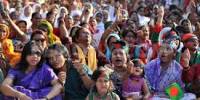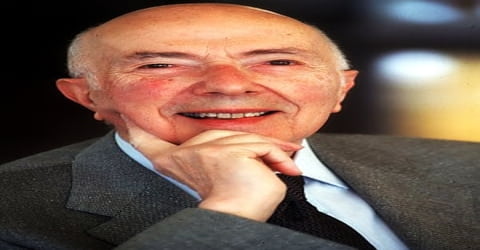Introduction:
For centuries Bangladesh has been an agri cultural society. So, its folk culture is based on the rituals and rhythms of rural life. Despite the trends of urbanization and globalization our culture of both the urban and rural communities are folk oriented.
Both our practical and cultural life are based on Australoid and Drabid Society. But there is no documentary history where we can get the depiction of their times and culture. On the basis of different information we can come to conclusion that our lifestyle has been influenced by the arrival and permanent living at different nations in course of time, the amalgamation of different lifestyle have led to a distinctive cultural trend.
The development of culture is not possible without tradition. The mode of life for a long period of time builds up the foundation of culture. Basically, culture is tradition.
Objectives:
There is a specific objective behind every action. The objective of preparing this Dissertation paper is to explore the culture of Bangladesh-
A .To know the different aspects of the folk culture in of Bangladesh
B. To reflect know background cultural heritage of Bangladesh
c. To see the influence of culture in our personal, social and national life.
D. To look in to conservation of our folk Culture.
Periphery:
The title of this Dissertation paper is “A Study on the Folk Couture of Bangladesh”. The Dissertation paper has been prepared to focus on the folk culture of Bangladesh that has been done in the light of folk literature. What is culture? The sources and features of the cultures of Bangladesh, the historical development of the culture of Bangladesh, the classification of the culture of Bangladesh, the section of the folk culture of Bangladesh on the basis of its subject matter and their subject matter have been discussed.
Method:
I have adopted the method of collecting data from secondary sources. Data has been derived form various types of sources e.g. form various books, reviews, literature paper and web site etc.
Limitation:
Time-limitation was a problem for the preparation of this paper. So, it was not possible to collect primary data from the practical field. Culture is a comprehensive idea. So it was not possible do depict a complete picture of culture. Moreover, because of the scarcity of latest publications I had to collect and analyze information from limited books. It was a troublesome work for me.
What is culture :
There are diversified definitions about culture. The most unique definition is seen in ‘Sangskriti Katha by Motaher Hossain Choudhury. In this book he says, “Culture means to live well in diversified ways, in noble ways, to live tasting the flavour of variegated feelings of human society and nature, to live with reading poetry, blooming flower, flowing river, whit the azure of sky, with the greenery, in the sacrifice of life, being close partner of different nations and different countries with the evolution of human civilization ……………… to live embracing the world. “
According to Dr. Enamul Haque, “Reformation belonging to countrymen is culture.” Dr. Wakil Ahmed says, “culture is in one hand the mode of life e.g. behaviour, manner, rites and rituals, festivals, daily activities, education, sports, amenities etc; in the other hand all the materials and ingredients for leading life e.g. homestead, foods, furniture, vehicles, machinery, clothes, ornaments etc. Thirdly it covers literature, music, painting, sculpture, philosophy, science etc. E.B. Taylor says, “Culture is a conscious striving towards progress and perfection.”
The Sources and features of the culture of Bangladesh:
The cultural background of Bangladesh is diverse. The original inhabitants of this area were pre-Aryan. After words, they were influenced by Aryan thoughts. Again this culture is influenced by the ingredients of Muslim culture of Turkey, Arab, Iran and Middle-Asia. Lastly, with the arrival of the Europeans especially the British, A different cultural trend was set. In this way, in course of time, our culture gradually developed with the essence of defferent cultures. If we want to be introduced to our cultural background, we need to take resort to foreigners. Because of the climatic condition of Bangladesh, it was not possible to preserve the history of cultural life. So, we have to find out our cultural entity in the Kamasutra by Batsayan, Brihat Sanghita by Baraha Mihir, in Chenakya, Kalidas etc.
Historical Development of the culture of Bangladesh:
From historical point of view the culture of Bangladesh can be defided into some categories.
The origin of culture (From Pal Regime to Turkish Conquest):
Australoid, Dravid, Mongoloid and Negrito were the main among the pre-Aryan inhabitants. Each of these races has its distinctive archaeological and cultural identity. There are difference between their creed and mode of life. Both matriarchal and patriarchic system prevailed. Their economic base was dependent on agro-based economic development and cottage industry.
We can get the continuous history of our cultural activities from the reign of Pal Dynasty. Under the auspices of Pal Kings Bangladesh occupies a glorious place in the international Buddhist arena through some Buddhist societies and Buddhist Bihar. There are signs of culture and civilization at Mynamari, Pharpur, Mohasthangar etc. which are the original source of our cultural heritage.
During the reign of Sen Dynasty culture was influenced by Brahmanism.
Culture of Bangladesh in the middle age (Muslim rein):
A new trend started in the culture of Bangladesh in the Middle age with the arrival of the Muslims. Pirs, Falirs and Darvishes who came from the West influenced the inhabitants of this land. In the of Muslims, Bengali language and literature flourished greatly. Ramayan and Mohabharat were translated. Romantic poetry was composed under the auspices of Muslim Rulers. Most noticeable among these are Mymensingha Gitika, Gazir Gan etc. An Islamic culture developed after the arrival of the Muslims.
Culture in Modern age :
The Portuguese merchant came to this country first. Then came the Dutch, the French and the English. When the English came to power, the culture of Bangladesh was under pressure. A new aristocratic culture evolved under the influence of English language, literature and culture. After the establishment of FortWilliamCollege, some literary persons like Ram Ram Bose contributed to Bengali prose. European culture greatly dominated Bengali culture.
Afterwards, during the Pakistani reign the Bangalees started to search for their identity. In doing so, they discovered their image in the non-communal folk tradition. After the language movement, a liberal, pragmatic and secular attitude originated.
Classification of the culture of Bangladesh:
There are two main streams of the national culture of a country e.g. Urban culture and folk culture. Vatican city is a city state. So, there is only urban culture here. But there are three cultural streams in Bangladesh e.g. urban culture, folk culture and tribal culture. Folk culture is what has been flourished through centuries focussing the life style of the huge population of rural areas.
Urban culture:
Urban culture evolves in the small purview of urban area from the occupation, dressing, festivals, communication and production system of the urban people. This culture is delicate, complex, diverse, dynamic and pompous. It expands and excels in the process of alteration and transformation through inclusion and exclusion.
Folk culture:
The nature-reliant life style of rural people is mainly traditional, commonplace and slow. The villagers do not get the opportunity of formal learning. They lead their lives gathering experience from their ancestors about production, vehicle, machinery, dress-up, foods, rites and rituals, entertainment etc. The salient features of their culture are simplicity, vividness and candidness.
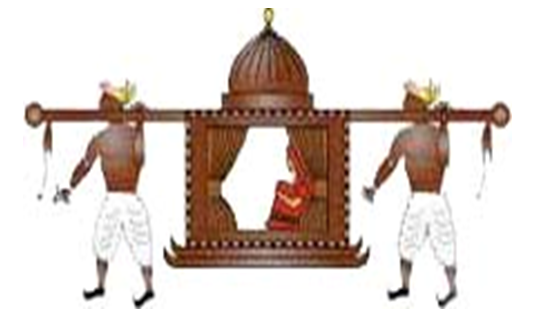
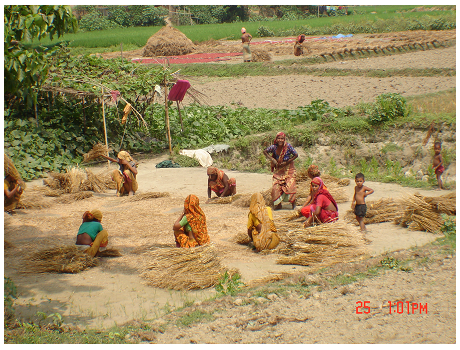
Urban Culture:
There are thirty-two tribes in Bangladesh. In one sense tribal culture belongs to the Folk culture. But they are regarded as distinctive one because of some difference in several aspects. Tribal culture is, to a great extent, conservative, stagnant and tradition oriented. They tribes are remaining where they started from, because they are separated from the outer world and deprived of education. In stead of coming forward to enjoy modern facilities by mixing with the greater society, they are rather sticking to the superstition, custom and tradition in the name of keeping up separate entity. No noticeable change is seen in their culture.
Types of Folk culture on the basis of subject matter:
On the basis of nature the folk culture of Bangladesh is divided into four types. e.g.:
i) Material culture
ii) Formalized culture
iii) Functional culture
iv) Performing culture.
Material culture:
Material culture covers those things which are used by people for leading their lives e.g. houses, furniture, utensils, vehicles, tools and machinery etc.
Formalized culture:
Formalized culture covers oral folk culture. Paintings belong to this group. The elements of formalized culture are folk song, folk drama, rhymes, riddles, proverbs, folk tales, gitika, incantation etc.
Functional culture:
Functional culture covers folk drama, Jatra, dance, games and sports. These are performed by acting. Baul, Gambhira etc. are presented through the combination of song, dance and acting. Jary dance is related with Jari song, Sari dance with Sari Song, Lathi dance with Lathi song. These are the source of recreation for all people.
Folk art of Bangladesh:
Folk art is a traditional art that has been evolved over time through communal practice. This art combines aestheticism with emotion. Again, this artistic thing meets our daily necessities. Some folk arts related to rites and rituals are Alpana, Manasaghat, Mangal Ghat, Laksmir Sara etc.
Ingredients of folk art:
The ingredients of folk art are very ordinary. Different types of crafts are made of locally abatable ingredients such as wood, cloth, thread, cane, horn, bamboo, conch-shell, jute, sola, reeds etc. Some precious metals like gold, silvers, brass, tusk etc. are also used. The tools of folk art are also ordinary
The motifs of folk art:
Folk art uses traditional motifs reflecting the land and its people. Different forms of folk art tend to repeat these common motifs. For instance, the lotus, the sun, the cree-of-life, flowery creepers etc re seen in paintings, EMBROIDERY, weaving, carving and engraving, Other common motifs are fish, elephant, horse, peacock, swastika, circle, waves, temple, mosque etc. Many of these motifs have symbolical meanings. For example, the fish represents fertility, the sheaf of paddy prosperity, the lotus purity and the swastika- usually more curvilinear than the Nizi symbol-good fortune.
Alpana a popular folk art associated with Hindu women’s observance of religious vratas or vows such as Laksmivrata, Senjutivrata, Maghmangalvrata. Haricharanvrata and Basudharavrata. Ti is also drawn on the occasion of Hindu weddings and ANNAPRASAN. Common motifs drawn during weddings include the lotus and creepers. Alpna re drawn at Muslim weddings, especially on the occasion of the GAYE HALUD. The alpana motifs drawn at Muslim functions are, however, quite different from those at vratas. On 21st February as well alpanas using floral motifs and geometric patterns are painted on the roads leading to the SHAHEED MINAR.
White paste made of pounded rice is the main raw material for alpala. Depending on the occasion, brick powder, ash. water mixed with cow dung. vermilion and turm paste are also used. Alpanas for vratas are drawn with a finger or a pices of wood. In uran areas, alpanas are painted with enamel paints and brushes. Almna motifs do not show realistic details. The senjutivrata alpana, representing a woman with many children is shown abstract lines. Similarly, the laksmivrata alpana, representing the godess Laksmi’s foot, is shown simply as a human footprint.
Bamboo craft
Bamboo is used to make houses as well as essential implements for farming and fishing as well as domestic use. Bamboo is used to make musical instruments such as the EKTARA and the flue. Bamboo tenes and partitions are often decorated with floral motifs aie geometric patterns. Fancy fans made of bamboo depict trees, birds, elephants, flowers and conch-shaped leaves.

Cane craft like bamboo, cane is also used to make a variety of household and fancy product including furniture. Chairs, stools, sofa sets, bookshelves, baskets, table lamps, partitions and hookah holds and attractive and affordable. Though less commonly used in urban areas, fancy mats called NAKSHI APTI (pictorial mat) or sitalpati (cool mat), continue to be in demand both for their comfort and attractiveness.
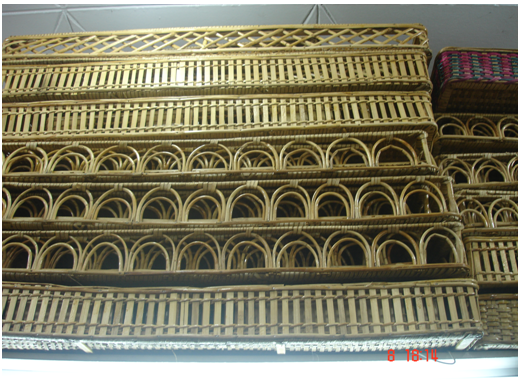
Conchshell craft Conch shells are used to make bangles, armlets, rings, lockets, buttons, hairpins and clips. Vermilion containers, incense holders, ashtrays, table lamps etc are also made with shells. Despite their primitive technology, the conch-cutters of Shankhari Patti in Dhaka produce finely crafted articles.
Daruchitra The art of wood engraving is an ancient craft, used for decorating door frames, pillars, windows, palanquins, boat prows, toys and dolls. The designs are carved out and the plain surfaces are then painted. Door frames and pillars are painted with creepers, palanquins with flowers, creepers and geometric patterns, and boats with the swastika, the moon, stars, birds and fish.
 Dewalchitra or wall painting. Images of deities are painted on the walls of mud houses in northern Bengal in the belief that these images will protect the house and its inmates from evil. Followers and leaves are painted to beautify the dwelling place. Apart from alpana designs motifs include the swastika, the goddess Laksmi seated on a lotus, the heroes of the PURANAS, sheaves of paddy, creepers, peacocks and elephants, Seance from the story of RRISHNA or RAMA are paintings have also become popular in Dhaka city. Many of these paintings are broken up into panels painted in different styles of folk art. The boundary wall of the Institute of Fine Arts which faces Kazi Nazrul Islam Roas, for example, has acenes drawn in nakshi kantha, GAZIR PAT, and ghatachitra styles. In addition to traditional motifs and seenes, depictions of the WAR OF LIBERATION are also common. During the observances of EKUSHEY, the walls facing the Shaheed Minar are painted with quotations in BANGLA SCRIPT.
Dewalchitra or wall painting. Images of deities are painted on the walls of mud houses in northern Bengal in the belief that these images will protect the house and its inmates from evil. Followers and leaves are painted to beautify the dwelling place. Apart from alpana designs motifs include the swastika, the goddess Laksmi seated on a lotus, the heroes of the PURANAS, sheaves of paddy, creepers, peacocks and elephants, Seance from the story of RRISHNA or RAMA are paintings have also become popular in Dhaka city. Many of these paintings are broken up into panels painted in different styles of folk art. The boundary wall of the Institute of Fine Arts which faces Kazi Nazrul Islam Roas, for example, has acenes drawn in nakshi kantha, GAZIR PAT, and ghatachitra styles. In addition to traditional motifs and seenes, depictions of the WAR OF LIBERATION are also common. During the observances of EKUSHEY, the walls facing the Shaheed Minar are painted with quotations in BANGLA SCRIPT.
Gazir Pat a form of scroll paintings, used to illustrate the life of Gazi Pir, king of tigers painted in panel form, these illustrations depct various miraculous events associated with Gazi Pir. One such panel shows Gazi seated on a tiger with its tail lifted. Gazir pat also includes other scenes and motifs, such as the goddess Ganga riding the makara a mythological aquatic animal, a cow being grabbed by a tiger, and Daksin Ray, also regarded as a king of tigers. holding a mallet in his hand. There are still one or two PATUYAS in Munshiganj and Narsingdi who paint Gazir pat.
Ghatachitra Paintings on earthen pitchers or ghat: There are various types of ghatachitra such as managalghat, manasahgat, nagaghat, laksmighat, kartiker bhand and daksinrayer bara, the names being derived from the deity painted on the pitcher. Thus, manasaghats depict MANASA, the snake goddess, while nagaghats depict hooded snakes. A pitcher with the image of an eight-headed snake is called ‘astanaga ghat.’ Similarly, pitcher depicting Laksmi, the goddess of wealth, is called ‘laksmir ghat,‘ while a ghat with the image of Daksin Ray, the tiger got, is known as ‘daksn rayer bra.’ The manasaghat is a most ornate and popular of this folk genre.
Jute craft Aprat form being the raw manorial for hessian and carpets, jute is also used to make mats, bags, and hanging string bags or sika, used in homes to hang foodstuff out of the reach of animals. To make sikas, jute twine is braided and then tied in various patterns such as tearful, puntiful and takaful. The sikas are given different names such as muthasika, chaksika, kadisika and nemtasika on the basis of their size, shape and designs Kadisika, for example, is threaded with cowries.
Karandichitra panel paintings on sola, depicting the goddess Manasa. These paintings are made on the occasion of Manasa puja. First a karanki, a square frame resembling a temple, is made with sola and paper. Then bozes are drown at the top and the bottom portrying Manasa, BEHULA, Laksindar, Chard Sadagar, Behula’s seven brothers and their wives, a sage, fishermen, snake charmers, washerwomen, trumpeters and coiled snakes. At the end of the puja, the krandi is set afloat on water.
Metalcraft Gold and silver ornaments and plates, glasses, pitchers and mugs made of silver and bell metal have been in use since ancient times. Flower vases, ashtrays, table lamps, containers for cosmetics, and various decoration pieces are also being made. Various motifs such as flowers, creepers, birds and geometric patterns are engraved on pitchers, glasses and mugs. Gold and silver ornaments, to dorn women from head to foot, are made in innumerable designs. Traditional ornaments include the makaramukhi mal (the makara-faced anklet), an anklet designed in the shape of the makara. Lockets are designed like flowers, butterflies and geometric patterns. Ornaments are also set with precious cut stones, gems and pearls.
Nakshi Kantha or embroidered quilt is made and used almost everywhere in Bangladesh. However, the nakshi kanthas of Rajshahi, Jessore, and Faridpur arre most famous for stitchcraft and picturesque designs. Several lyers of old cloth are put together to make these quilts. Apart from being used to make pillow cases and covers, rayer mats, seats for puja, small bags for keeping mirrors and combs, filaf (covers) for books, covers for foods, and dastarkhan or dining mats. The desings were traditionally drawn free hand by women who worked leisurely in their spare time. At present much nakshi kantha work is done by NGOS and handicraft organizations for commercial purposes. Common motifs are the lotus, the suff, the moon, stars, leaves, trees, flowering creepers, human figures, deities, horses, elephants, fish, birds, TAZIAS and rath. Elaborately embroidered quilts depict scenes from mythology or contemporary life. Traditionally, threads drawn from sari borders were used. At present embroidery thread is used or skeins of yarn.
Nakshi moulds Decorative moulds or blocks of varied designs are made with clay, stone or wood. Wooden blocks are employed to print fabrics using different colours. Moulds of wood, clay and stone are used to make decorative cakes and sweets. Stone moulds are engraved with creepers. flowers and fruits. Wooden moulds are made by carpenters, but clay moulds are made by village women themselves.
Nakshi pitha or decorative cakes are made by shaping dough of pounded rice into various designs. These are then fried in oil and socked in sugar syrup. Traditional motifs for NAKSHI PITHA are geometric patterns, wheels, betel leat, flowers in bloom, fish, birds etc. Nakshi pithas are more popular in Dhaka and Mymensingh and are especially made to guests at weddings.
Ornamental woodwork A variety of motifs and designs are carved on doors, windows, pillars, joists, rafters, chests, beds, divans, low seats, cake moulds, cases of musical instruments, palanquins, chariots, boats and dolls. Common motifs include the lotus, birds, flowery creepers, circles and geometric designs. The lotus is engraved on doors, beds, chests and low seats; flowery creepers and geometric patterns on door frames, pillars, bed posts and palanquins; peacocks and parrots on cases of musical instruments; and lotuses and peacocks on boats. The BangladeshNationalMuseum in Dhaka has in its collection an exquisitely carved wooden statue of woman named ‘sursundari’.
Painted masks In many folk festivals, artistes would wear painted masks. In religious dances the performers would wear masks depicting the faces of the deities. Shiva’s face. for example, would be made by dabbing mud on a piece of cloth fixed around a white and black and her tongue red.
Patachitra of different or scroll paintings by professional artists, known as Patuyas, re used to illustrate different narratives. These scroll paintings date back to the Buddhist period when Buddhist bhikkus known as ‘maskari’ used to spread the message of Buddhism by showing pictures to illustrate stories of the Buddha. Subsequently, during Hindu rule, these scroll paintings depicted stories from the Puranas. Many Hindus were converted to Islam after the Muslim conquest of Bengal in the 13th century. They did not abandon the trade they had learned, but added Muslim stories to their reperioire. Thus, they continued to paint stories of Krishnalila, Ramalila, and Manasalila, stories of krishna, Rama nad Manasa and at the same time painted scrolls depicting the deeds of Gazi Pir and Bibi Sonabhan and the tragixc events at Karbala.
The illustrations were first painted on silk cloth or linen and later on paper made of cotton-pulp. There are two kinds of Patachitra in Bangladesh: single pictures on a squatre canvas and multiple pictures on a long roll. Kalighat Paintings belong to the first category. This style of painting developed during the 18th-19th centuries after the establishment of Kolkata. The Kalghat school disappeared after western style painting became popular.
The traditional patachitra illustrates different episodes of a story on a scroll up to 30 feet long. As the scrolls are wrapped around sticks, these are also known as ‘wrapped pictures.’ There is another kind of scroll known as ‘panchakalyani pat’ which contains illustrations deities.
Pottery Inexpensive household utensils are made of clay as are images of Hindu gods and goddesses for puja and devotional rites. Dolls, toys, and decoration pieces are also made in most parts of Bangladesh. Some clay products are decorated with designs of leaves, flowers, birds etc while others are left plain.
Sakher handi or clay pots painted with motifs of fish, birds, lotus, leaves and geometric designs in bold brush strokes. Common colours are red, yellow and green. Both motifs and colours are symbolic of fertility. Which is why these pots are used to carry gifts of fruit and sweets at weddings. Rajshahi is well known for these pots.
Sarachitra this large clay plate painted with the image of the goddess Laksmi is also known as ‘Laksmir sara’ or Laksmi’s pat. The plate is first painted white and then the image of the deity, often shown seated on an owl, is painted in yellow, red, and black. On some lids, she is shown with Durga, her mother, and Saraswafi, her sister. On other plates she is shown in a panel with the imates of Radha and Krishna.
Sola craft Sola or sponge wood, obtained from a plant that grows in paddy fields and shallow water-bodies, is used to make a variety of decorative articles. Traditional articles include back drops for images of deities and to par, or headgear, for brides and bridegrooms. Topars are usually decorated with kadam flowers. Other items include dolls, birds: elephants, flowers, boats, garlands etc. Vaishnavas install sola images of Radha and Krishna on platforms at rasa festivals and kadam flower are hung in houses in the belief than they bring good luck. Sola hats were popular during British rule. A sharp knife and a pair of scissors are the main implements for this craft.
Ulki or tattooing is a form of body art using permanent pigments. Men and women of some Hindu castes tattoo parts of their body for religious reasons, usually with motifs of the sun, birds, snakes or circles. Vaishnavas tattoo pictures of Radha and Krishna united in an embrace. Tattooing is done by pricking the juice of kesutia (Eclipta prostate) leaves to obtain a bluish clour. There are other forms of body painting that are temporary. Bengali brides, both Hindu and Muslim, have their faces dotted with sandalwood paste. Muslim brides use mehendi or henna to paint their palms with intricate designs.
Both the housewife painting alpana or stitching a kantha tand the traditional craftsman working in metal or wood have contributed to the rich folk art of Bengal. Drawing upon traditional motifs as well as upon the world around them, the produce vibrant pieces of art by using simple raw materials and humble implements. Whether fulfilling an aesthetic need, performing a religious duty or pursuing a livelihood, these paid and unpaid lolk artists have made Bangladesh a vast storehouse of colorful and varied folk arts.
Findings :
After the study, avoid picture of the folk culture of Bangles has been found.
The findings of the study are the following :
i) The source of our folk culture is the life of the rural people.
ii) Our folk culture is composed of several ingrates types of ingredients such as
a) Material elements
b) Formal elements
c) Function elements and
d) Performance elements
iii) Components of folk culture are the following
a) Folk songs
b) Folk Jales
c) Idioms
d) Puzzles
e) Folk Drama
f) Folk rituals
g) Folk carryall and
h) Folk Art /Ulkey.
Recommendation
i) The Condition of Folk culture of Bangladesh is not good. So Government /concern authority should take necessary steps to save and protect folk culture as early as. Possible .
- Ø Government should take policy culture in men / women in folk culture in Bangladesh.
- Ø Build up public awareness through. Education for our national heritage.
- Ø Govt. should take necessary steps for list publicity
- Ø The elements of the folk culture should be concerned from any sort of distortion /destruction.
- Ø Government should form a committee to rescued folk elements from various races of Bangladesh .
- Ø Steps should be taken at Govt. level to conserve the endangered elements of folk culture.
- Ø The qualitative value of the folk elements should be enhanced.
- Ø It should be freed from urban culture.
- Ø It should be freed from the influence of our culture.
Conclusion
The introduction or picture of a nation is found in her culture. If the culture collapses, the nation will be identify less. So every nation should protect or preserve her culture for her existence.
The folklore culture of Bangles is now on the way of ruin. So it is the duty of every citizen nurture it and to prepare it. If we can protect our folk one culture, the nation will find her existence very eerily If is impossible to reflect all the folk one culture of within this very short line. I hope, it will be fulfill at the hand of extraordinary expert in the course of him.



